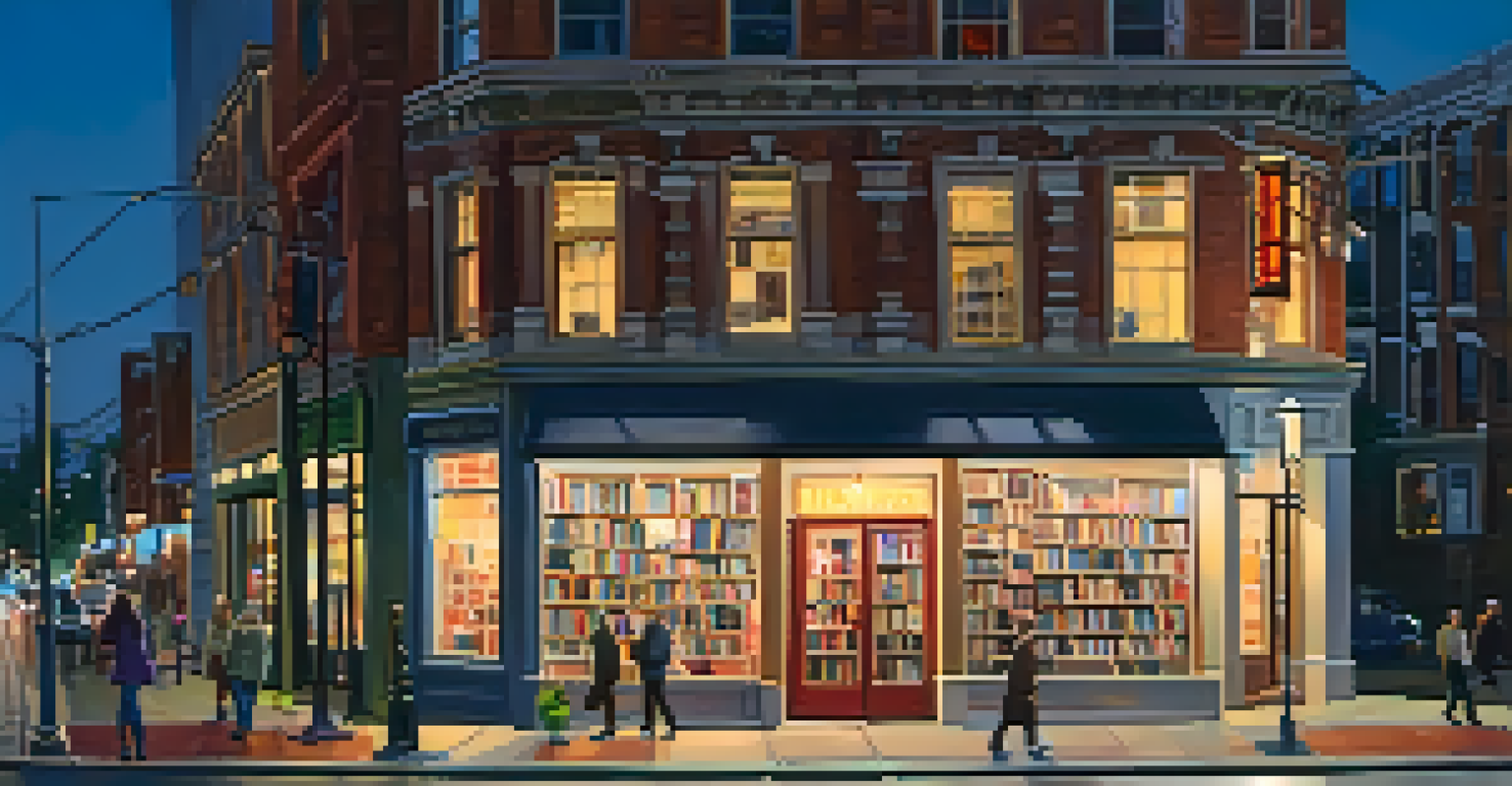San Francisco and the Beat Generation: Cultural Revolution Roots

The Birth of the Beat Generation in San Francisco
The Beat Generation emerged in the late 1940s, with San Francisco as its vibrant backdrop. Writers like Jack Kerouac and Allen Ginsberg found the city’s eclectic streets to be a perfect canvas for their revolutionary ideas. This movement sought to challenge societal norms and explore themes of spirituality, sexuality, and freedom. San Francisco’s open-minded culture provided fertile ground for these radical thoughts to flourish.
The only people for me are the mad ones, the ones who are mad to live, mad to talk, mad to be saved, desirous of everything at the same time, the ones who never yawn or say a commonplace thing, but burn, burn, burn like fabulous yellow roman candles exploding like spiders across the stars.
The city was not just a setting; it was a character in the Beat narrative. Places like City Lights Bookstore became hubs of intellectual exchange and creativity. The communal spirit of San Francisco resonated with the Beats, inspiring their unabashed exploration of life. Their artistic expressions blended seamlessly with the city’s diverse tapestry, reflecting its dynamism.
As the Beat poets and writers began to gain recognition, San Francisco became synonymous with their ideals. The city’s streets echoed with their revolutionary verses, captivating the disenchanted youth of the era. The Beat Generation’s connection to San Francisco played a pivotal role in cementing the city’s status as a center for cultural revolutions.
Key Figures of the Beat Movement
Prominent figures like Jack Kerouac, Allen Ginsberg, and William S. Burroughs defined the Beat Generation. Kerouac’s spontaneous prose and Ginsberg’s passionate poetry challenged traditional literary forms. Their works often drew inspiration from their experiences in San Francisco, making the city an essential part of their stories. Through their writings, they explored the complexities of modern life and the quest for authenticity.

Ginsberg's poem 'Howl,' for instance, became a cultural touchstone, reflecting the angst and disillusionment of the post-war generation. Kerouac’s 'On the Road' captured the spirit of adventure and the search for meaning in American life. These writers didn’t just create art; they sparked conversations about freedom, consciousness, and societal expectations.
San Francisco: The Beat's Canvas
The eclectic streets of San Francisco served as a vibrant backdrop for the Beat Generation, inspiring writers like Jack Kerouac and Allen Ginsberg to challenge societal norms.
Their influence extended beyond literature, impacting music, visual arts, and even politics. The Beats encouraged a sense of rebellion and nonconformity, inviting others to break free from societal constraints. Through their creative endeavors, they laid the groundwork for future movements, forever changing the landscape of American culture.
The Role of San Francisco's Neighborhoods
San Francisco’s neighborhoods played a significant role in shaping the Beat Generation. The North Beach area, often referred to as the 'literary district,' was a melting pot of artists and thinkers. Cafés and bars became meeting places where ideas flowed as freely as the coffee. The vibrant atmosphere fostered camaraderie among writers, musicians, and painters alike.
I saw the best minds of my generation destroyed by madness, starving hysterical naked, dragging themselves through the negro streets at dawn looking for an angry fix.
Haight-Ashbury, another iconic neighborhood, became the epicenter of the counterculture movement. Its colorful streets and open-minded residents attracted those seeking freedom and alternative lifestyles. The Beats embraced the spirit of Haight-Ashbury, celebrating individuality and self-expression. The neighborhood's influence extended beyond the Beats, paving the way for the 1960s hippie movement.
These neighborhoods were not merely backdrops; they were integral to the cultural revolution. The community’s support and shared values fueled the creativity of the Beat Generation. San Francisco's streets became a canvas for artistic expression, forever linking the city’s identity with the revolutionary ideals of the Beats.
The Beats and the Search for Spirituality
Spirituality was a cornerstone of the Beat Generation, deeply intertwined with their experiences in San Francisco. Many Beats sought alternative forms of spirituality, exploring Eastern philosophies and mysticism. This quest for meaning led them to embrace practices like Zen Buddhism, which encouraged mindfulness and presence. The city’s progressive environment provided a safe space for these explorations.
San Francisco's diverse spiritual landscape allowed the Beats to engage with various beliefs. Temples, meditation centers, and gatherings became places of connection and reflection. The Beats often infused their works with these spiritual themes, creating a unique fusion of literary and philosophical ideas. Their writings resonated with those searching for deeper understanding in a rapidly changing world.
Key Figures Shaping Beat Culture
Prominent figures such as Kerouac and Ginsberg not only defined the Beat Generation through their revolutionary writings but also sparked broader conversations about freedom and authenticity.
This spiritual exploration was not without its challenges, as the Beats grappled with the tension between materialism and transcendence. Their journey towards enlightenment often mirrored the city’s own evolving identity, making their experiences universally relatable. The Beat Generation’s spiritual quest remains a defining aspect of their legacy, influencing generations in their search for authenticity.
Literary Contributions to American Culture
The literary contributions of the Beat Generation had a profound impact on American culture. Their bold narratives and innovative styles broke away from traditional literary conventions. By embracing spontaneity and raw emotion, the Beats opened the door for new forms of expression. Their works challenged readers to confront uncomfortable truths about society and themselves.
Books like 'On the Road' and 'Naked Lunch' not only pushed boundaries but also sparked conversations about censorship, freedom of expression, and the role of art in society. The Beats encouraged writers to experiment with their craft, paving the way for future literary movements. This sense of liberation in writing inspired countless authors, musicians, and artists to embrace their unique voices.
The legacy of Beat literature continues to resonate today, influencing contemporary writers and artists. Their fearless exploration of identity and experience laid the foundation for the countercultural movements that followed. By redefining what it meant to be an artist in America, the Beats forever altered the cultural landscape, ensuring their place in history.
The Beat Generation's Influence on Music
The Beat Generation’s influence extended far beyond literature; it also significantly impacted the music scene. Jazz, blues, and folk music resonated with the Beats, providing a soundtrack for their revolutionary ideas. Musicians like Bob Dylan and Thelonious Monk acknowledged the profound effect the Beats had on their work. The spirit of improvisation found in jazz mirrored the spontaneity of Beat poetry.
Beat poets often performed their work alongside musicians, creating a fusion of sound and word. These performances became a celebration of artistic collaboration, attracting diverse audiences. Venues in San Francisco, such as The Fillmore, became iconic spaces for these creative expressions. The Beats' embrace of music as a form of artistic expression helped bridge the gap between different art forms.
Enduring Legacy of the Beats
The Beat Generation's emphasis on self-expression and social justice continues to inspire modern movements, highlighting their lasting impact on culture and art.
This musical legacy paved the way for future genres, including rock and roll and the folk revival. The cultural revolution sparked by the Beats laid the foundation for the music of the 1960s and beyond. Their influence continues to echo in contemporary music, reminding us of the power of creativity and collaboration in shaping cultural movements.
The Enduring Legacy of the Beat Generation
The legacy of the Beat Generation continues to shape modern culture and art. Their revolutionary ideas about freedom, self-expression, and social justice have inspired countless movements. From the civil rights movement to the LGBTQ+ rights movement, the Beats laid the groundwork for societal change. Their emphasis on authenticity and individuality encourages people to embrace their true selves.
San Francisco remains a symbol of this legacy, attracting artists, writers, and activists who seek to challenge the status quo. The city’s vibrant arts scene still honors the spirit of the Beats, fostering creativity and innovation. Festivals, readings, and events celebrate their contributions, ensuring that their ideals remain alive and relevant.

As we reflect on the Beat Generation, we recognize the importance of their message in today’s world. Their courage to question societal norms and embrace diversity continues to inspire new generations. The Beats remind us that cultural revolutions are not just historical events; they are ongoing journeys toward a more inclusive and expressive society.